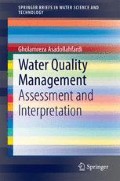Abstract
Often in water quality management, understanding the relationship between input and output data might be a complicated process. In this situation Data Driven Models using information and collected data (input data) find out the relationship between inputs and outputs. In this regard, Artificial Neural Network (ANN) is one of the Data Driven Models which has recently been applied as a tool for modeling complicated processes. In this chapter, after reviewing the developing process of ANN in water quality management, the theory of the ANN is mentioned in detail for both static and dynamic methods. Data preparation, learning rate and model efficiency including selection of number of neurons in hiding layer which has a minimum error in learning rate and network efficiency is described in detail. At the end step, as a case study water quality of Zaribar Lake located in the Northwestern part of Iran, using Multilayer Perceptron (MLP) neural network method are described.
Access this chapter
Tax calculation will be finalised at checkout
Purchases are for personal use only
References
Asadollahfardi G, Khodadadi A, Gharayloo R (2010) The assessment of effective factors on Anzali wetland pollution using artificial neural networks. Asian J Water Environ Pollut 7(2):23–30
Asadollahfardi G, Hemati A, Moradinejad S, Asadollahfardi R (2013) Sodium adsorption ratio (SAR) prediction of the Chalghazi river using artificial neural network (ANN) Iran. Curr World Environ 8(2):169–178
Asadollahfardi G, Taklify A, Ghanbari A (2012) Application of artificial neural network to predict TDS in Talkheh Rud River. J Irrig Drain Eng 138(4):363–370
Burkholder J (2000) Critical needs in harmful algal bloom research. Opportunities for environmental applications of marine biotechnology national academy of sciences. National Research Council, Washington, DC, pp 126–149
Cybenko G (1989) Approximation by superpositions of a sigmoidal function. Math Control Signals Syst 2(4):303–314
French M, Recknagel F (1994) Modeling of algal blooms in fresh water using artificial neural network. Computational Mechanic INC, Billerica, MA01821 (USA), 87–94. Hydrol Eng ASCE 5(2):123–137
Hornik K (1991) Approximation capabilities of multilayer feedforward networks. Neural Netw 4(2):251–257
Hornik K (1993) Some new results on neural network approximation. Neural Netw 6(8):1069–1072
Hornik K, StInchcombe M, White H (1989) Forward networks are universal approximators. Neural Netw 2(5):359–366
Huang W, Foo S (2002) Neural network modeling of salinity variation in Apalachicola River. Water Res 36(1):356–362
Irani J (1991) Study of hydro climatology of basin of Zarivar (Marivan), MSc thesis, Earth Science
Jiang Y, Xu Z, Yin H (2006) Study on improved BP artificial neural networks in eutrophication assessment of China eastern lakes. J Hydrodyn Ser B 18(3):528–532
Kanani S, Asadollahfardi G, Ghanbari A (2008) Application of artificial neural network to predict total dissolved solid in Achechay River basin. World Appl Sci J 4(5):646–654
Karul C, Soyupak S, Çilesiz AF, Akbay N, Germen E (2000) Case studies on the use of neural networks in eutrophication modeling. Ecol Model 134(2):145–152
Kennedy J, Neville A (1976) Basic statistical methods for engineers and scientists. Harper and Row, New York
Kuo J-T, Hsieh M-H, Lung W-S, She N (2007) Using artificial neural network for reservoir eutrophication prediction. Ecol Model 200(1):171–177
Leshno M, Lin VY, Pinkus A, Schocken S (1993) Multilayer feedforward networks with a nonpolynomial activation function can approximate any function. Neural Netw 6(6):861–867
Maier HR, Dandy GC, Burch MD (1998) Use of artificial neural networks for modelling cyanobacteria Anabaena spp. in the River Murray, South Australia. Ecol Model 105(2):257–272
Markus M, Tsai CW-S, Demissie M (2003) Uncertainty of weekly nitrate-nitrogen forecasts using artificial neural networks. J Environ Eng 129(3):267–274
MATLAB Version 7.0 (2007) Mathworks, Inc., Natick, MA
Menhaj M (1998) Artificial calculating, principal of ANN, vol 1. Amirkaber University Publisher, Iran (In Persian)
Menhaj M, Safepoor N (1998) Artificial calculating, vol 2. Professor Hesabi Publisher, Iran (In Persian)
Momcilo M, Christina WS, Tsai, Misganaw D (2003) Uncertainty of weekly nitrate-nitrogen forecasts using artificial neural networks. J Environ Eng 129:267–274
Panda S, Garg V, Chaubey I (2004) Artificial neural networks application in lake water quality estimation using satellite imagery. J Environ Inform 4(2):65–74
Recknagel F, Bobbin J, Whigham P, Wilson H (2002) Comparative application of artificial neural networks and genetic algorithms for multivariate time-series modelling of algal blooms in freshwater lakes. J Hydroinform 4:125–133
Recknagel F, French M, Harkonen P, Yabunaka K-I (1997) Artificial neural network approach for modelling and prediction of algal blooms. Ecol Model 96(1):11–28
Wei B, Sugiura N, Maekawa T (2001) Use of artificial neural network in the prediction of algal blooms. Water Res 35(8):2022–2028
Wilson H, Recknagel F (2001) Towards a generic artificial neural network model for dynamic predictions of algal abundance in freshwater lakes. Ecol Model 146(1):69–84
Author information
Authors and Affiliations
Corresponding author
Rights and permissions
Copyright information
© 2015 The Author(s)
About this chapter
Cite this chapter
Asadollahfardi, G. (2015). Artificial Neural Network. In: Water Quality Management. SpringerBriefs in Water Science and Technology. Springer, Berlin, Heidelberg. https://doi.org/10.1007/978-3-662-44725-3_5
Download citation
DOI: https://doi.org/10.1007/978-3-662-44725-3_5
Published:
Publisher Name: Springer, Berlin, Heidelberg
Print ISBN: 978-3-662-44724-6
Online ISBN: 978-3-662-44725-3
eBook Packages: Earth and Environmental ScienceEarth and Environmental Science (R0)

